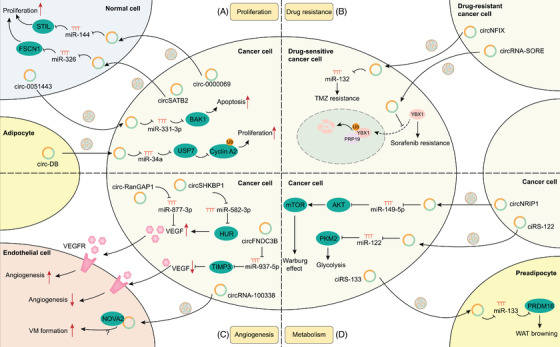FIGURE 4.

Molecular mechanisms of exosomal circular RNAs (circRNAs) in proliferation, drug resistance, angiogenesis and metabolism; (A) exosomal circRNAs are involved in proliferation. Exosomal circRNAs derived from cancer cells are delivered to normal cells to upregulate STIL and FSCN1 and promote cell proliferation (circ‐0000069, circSATB2, etc.). Exosomal circRNAs derived from normal cells are delivered to cancer cells to upregulate BAK1 and promote apoptosis (e.g., circ‐0051443, etc.) while exosomal circRNAs derived from adipocytes are delivered to cancer cells to activate the USP7/cyclin A2 pathway and promote proliferation (e.g., circ‐DB, etc.). (B) Exosomal circRNAs are involved in drug resistance. Exosomal circRNAs are delivered from drug‐resistant cancer cells to sensitive cells to spread drug resistance through the circNFIX/miR132 pathway and the interaction between circRNA‐SORE and YBX1 to prevent YBX1 nuclear translocation as well as PRP19‐mediated YBX1 ubiquitination and degradation. (C) Exosomal circRNAs are involved in angiogenesis. Exosomal circRNAs not only signal in cancer cells to regulate vascular endothelial growth factor expression and affect angiogenesis (circ‐RanGAP1, circSHKBP1, circFNDC3B, etc.) but are also delivered to endothelial cells and affect vasculogenic mimicry formation through the interaction between circRNA‐100338 and NOVA2 (which still needs further verification). (D) Exosomal circRNAs are involved in metabolism. Exosomal circRNAs are delivered between cancer cells, thus activating the AKT/mTOR pathway to promote the Warburg effect (e.g., circNRIP1, etc.) and elevating pyruvate kinase M2 isoform to promote glycolysis (e.g., ciRS‐122, etc.). Exosomal circRNAs are also delivered from cancer cells to preadipocytes to promote white adipose tissue browning (e.g., ciRS‐133, etc.)
